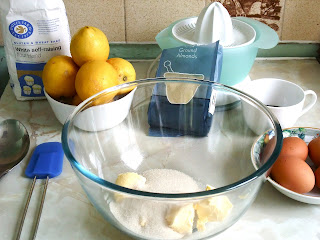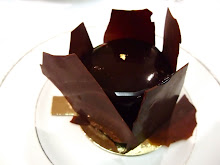
chewy & moist barley bread

after the first 14 hours in the fridge

and then I knocked it back!

30 minutes rising in the warming cupboard, just before baking
the verdict? delicious.
This bread was inspired by Trevor Vibert, a fellow bread-baker who gave me lots of great bread tips, including the idea of using barley. I'm not sure if this is what Trevor had in mind, but I found some barleycorn flour at my local supermarket and decided to experiment with barley bread. The barleycorn mixture consists of wholewheat flour, barley corn and seeds. I added a handful of cooked pearl barley that I was intending to use for a sweet potato, chickpea and tomato stew (am on a bit of a veggie kick at the moment) and the end result? A rustic wholemeal loaf with a fabulous malty flavour, chewy interior and extra crisp crust.
Will definitely be making this one again, so thank you Trevor ;-)
- 500g barleycorn flour
- 300ml cold water
- 1 sachet fast-acting bread yeast
- 1 tbsp grapeseed oil
- 1 tsp sugar
- 1/2 tsp salt
- handful cooked pearl barley
- seeds of choice (I like linseed and sesame but use what you have)
Method:
Basically the same as the spelt bread from a few days ago, except this time with a couple of minutes of kneading. Mix all the ingredients together, adding enough water to make a wet-ish dough, not too runny though. It should come off the sides of the mixing bowl whilst not being hard as a brick.
Knead for 5 minutes either in the bowl, or if you're feeling energetic, on the kitchen counter. This is a superb way to built strong upper arms and also to release any latent tension you might be experiencing! I happened to be listening to Marvin Gaye whilst kneading, highly recommend you do the same.
After kneading, cover the dough in the bowl with cling film and place in fridge. Leave overnight, preferably up to 18-24 hours. After about 14 hours I removed the dough from the bowl (you can see how big the mixture became before I knocked it back in the photo above) and sculpted it into a loaf shape to place in the bread tin. Cover again with cling film, this time spreading a bit of oil on the side of the cling touching the dough (this keeps the dough from clinging to the cling, so to speak) and then return to the fridge for another 4-8 hours, depending on when you want to bake it.
When you're ready to bake the bread, take the dough out of the fridge and allow to rise in a warm place for 30-45 minutes. I placed it in a warming cupboard where we keep linen and towels, don't place it in a tumble dryer as I once did when I was very young (I forgot the basic premise of the tumble dryer in that it tumbles. My Mamma was not impressed)
About 10 minutes before you're ready to bake, preheat the oven to 220C. Place the bread in the oven when it reaches this temperature and then reduce the heat to 200C after 10 minutes. This, I've probably mentioned before, gives the bread extra ooomph.
After 45 minutes-1 hour, the bread should be golden-brown, and if you give it a tap the crust the bread should sound hollow. It should also feel lighter than when you placed it in the oven...
Once baked, the bread will keep a couple of days. I made it yesterday and can attest to its moistness today - great with butter and honey, or with lashings of that sticky black stuff, Marmite. I imagine cheese would also be a fine match too.








































